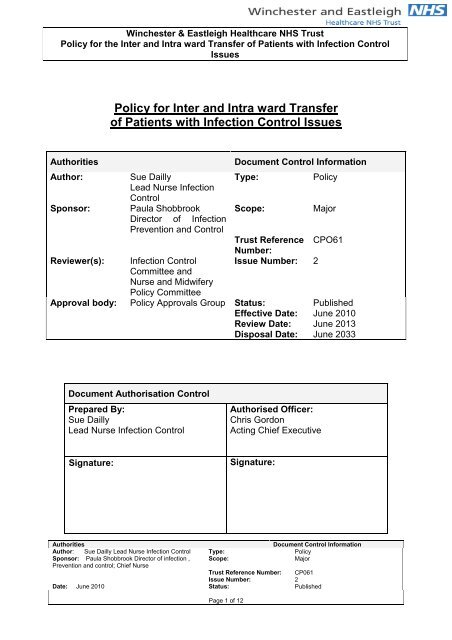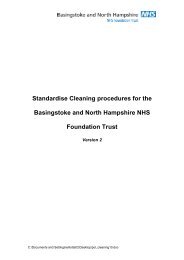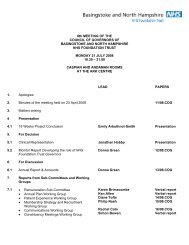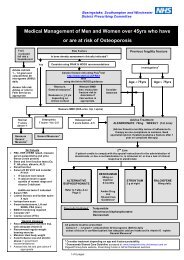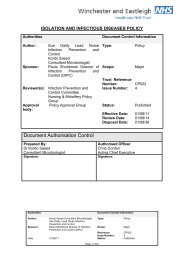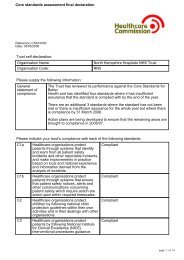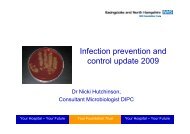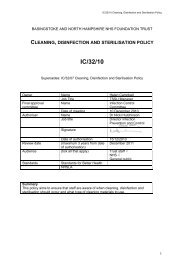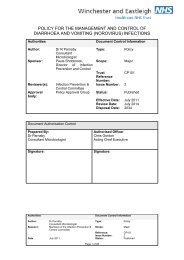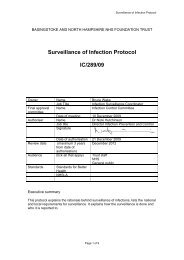Inter and intra ward transfer policy for patients with infection control ...
Inter and intra ward transfer policy for patients with infection control ...
Inter and intra ward transfer policy for patients with infection control ...
You also want an ePaper? Increase the reach of your titles
YUMPU automatically turns print PDFs into web optimized ePapers that Google loves.
Winchester & Eastleigh Healthcare NHS Trust<br />
Policy <strong>for</strong> the <strong>Inter</strong> <strong>and</strong> Intra <strong>ward</strong> Transfer of Patients <strong>with</strong> Infection Control<br />
Issues<br />
Policy <strong>for</strong> <strong>Inter</strong> <strong>and</strong> Intra <strong>ward</strong> Transfer<br />
of Patients <strong>with</strong> Infection Control Issues<br />
Authorities<br />
Author:<br />
Sponsor:<br />
Reviewer(s):<br />
Sue Dailly<br />
Lead Nurse Infection<br />
Control<br />
Paula Shobbrook<br />
Director of Infection<br />
Prevention <strong>and</strong> Control<br />
Infection Control<br />
Committee <strong>and</strong><br />
Nurse <strong>and</strong> Midwifery<br />
Policy Committee<br />
Document Control In<strong>for</strong>mation<br />
Type:<br />
Scope:<br />
Policy<br />
Major<br />
Trust Reference CPO61<br />
Number:<br />
Issue Number: 2<br />
Approval body: Policy Approvals Group Status: Published<br />
Effective Date: June 2010<br />
Review Date: June 2013<br />
Disposal Date: June 2033<br />
Document Authorisation Control<br />
Prepared By:<br />
Sue Dailly<br />
Lead Nurse Infection Control<br />
Authorised Officer:<br />
Chris Gordon<br />
Acting Chief Executive<br />
Signature:<br />
Signature:<br />
Authorities<br />
Document Control In<strong>for</strong>mation<br />
Author: Sue Dailly Lead Nurse Infection Control Type: Policy<br />
Sponsor: Paula Shobbrook Director of <strong>infection</strong> , Scope:<br />
Major<br />
Prevention <strong>and</strong> <strong>control</strong>; Chief Nurse<br />
Trust Reference Number: CP061<br />
Issue Number: 2<br />
Date: June 2010 Status: Published<br />
Page 1 of 12
Winchester & Eastleigh Healthcare NHS Trust<br />
Policy <strong>for</strong> <strong>Inter</strong> <strong>and</strong> Intra <strong>ward</strong> Transfer of Patients <strong>with</strong> Infection Control Issues<br />
DOCUMENT CONTROL<br />
Document Amendments<br />
No. Details By Whom Date<br />
1 Up-dated to match Health Act 2006 S.Dailly, Lead<br />
Nurse Infection<br />
Control<br />
2 3 yearly review Up-dated to new <strong>policy</strong> <strong>for</strong>mat S.Dailly, Lead<br />
Nurse Infection<br />
Control<br />
Feb 2007<br />
May 2010<br />
Review Timetable<br />
Date Reason By Whom<br />
May 2010 3 year review Sue Dailly,<br />
Lead Nurse<br />
Infection<br />
Control<br />
May 2013 3 year review ICNs<br />
Date<br />
Completed<br />
May 2010<br />
Distribution List<br />
No Title<br />
1 Trust Intranet <strong>and</strong> Trust web site<br />
2<br />
3<br />
4<br />
5<br />
Authorities<br />
Document Control In<strong>for</strong>mation<br />
Author: Sue Dailly Lead Nurse Infection Control Type: Policy<br />
Sponsor: Paula Shobbrook Director of <strong>infection</strong> , Scope:<br />
Major<br />
Prevention <strong>and</strong> <strong>control</strong>; Chief Nurse<br />
Trust Reference Number: CPO61<br />
Issue Number: 2<br />
Date: June 2010 Status: Published<br />
Page 2 of 12
Winchester & Eastleigh Healthcare NHS Trust<br />
Policy <strong>for</strong> <strong>Inter</strong> <strong>and</strong> Intra <strong>ward</strong> Transfer of Patients <strong>with</strong> Infection Control Issues<br />
RELATED TRUST POLICIES<br />
CPO73 H<strong>and</strong> Hygiene Policy<br />
CPO76 St<strong>and</strong>ard Precautions <strong>and</strong> PPE Policy<br />
CPO77 Policy <strong>for</strong> Ward Closure Due to an Infection Control Issue<br />
CP010 Policy <strong>for</strong> management <strong>and</strong> <strong>control</strong> of diarrhoea <strong>and</strong> vomiting (Norovirus)<br />
Infections<br />
CPO28 Management of Suspected Cases of Viral Haemorrhagic Fever Policy<br />
CPO29 SARS/new strain influenza <strong>policy</strong><br />
CPO47 Tuberculosis <strong>and</strong> multiple drug resistant tuberculosis <strong>policy</strong><br />
CPO55 MRSA<br />
CPO64 Clostridium difficile <strong>policy</strong><br />
NP06 Safe moving of <strong>patients</strong> between clinical <strong>and</strong> other areas <strong>policy</strong><br />
Authorities<br />
Document Control In<strong>for</strong>mation<br />
Author: Sue Dailly Lead Nurse Infection Control Type: Policy<br />
Sponsor: Paula Shobbrook Director of <strong>infection</strong> , Scope:<br />
Major<br />
Prevention <strong>and</strong> <strong>control</strong>; Chief Nurse<br />
Trust Reference Number: CPO61<br />
Issue Number: 2<br />
Date: June 2010 Status: Published<br />
Page 3 of 12
Winchester & Eastleigh Healthcare NHS Trust<br />
Policy <strong>for</strong> <strong>Inter</strong> <strong>and</strong> Intra <strong>ward</strong> Transfer of Patients <strong>with</strong> Infection Control Issues<br />
Contents<br />
Section Title Page No.<br />
1. Purpose 5<br />
2. Scope 5<br />
3. Roles <strong>and</strong> Responsibilities 6<br />
4 Definitions 7<br />
5 Intra or <strong>Inter</strong><strong>ward</strong> <strong>transfer</strong> of <strong>patients</strong> <strong>for</strong> isolation 7<br />
6 Selection of <strong>patients</strong> to be <strong>transfer</strong>red to an MRSA 7<br />
‘free’ <strong>ward</strong>.<br />
7 Guidance on MRSA screening to aid bed 8<br />
management<br />
8 Patient <strong>transfer</strong> documentation 8<br />
9 Cleaning of bays or side rooms after <strong>transfer</strong>ring 9<br />
patient<br />
10 Portering Patients between <strong>ward</strong>s 9<br />
11 Transfer of <strong>patients</strong> out of the Trust 10<br />
12 Training Implications 10<br />
13 Monitoring Compliance <strong>and</strong> Effectiveness 10<br />
14 References 10<br />
Appendix 2 Equality Impact Assessment Tool 11<br />
Authorities<br />
Document Control In<strong>for</strong>mation<br />
Author: Sue Dailly Lead Nurse Infection Control Type: Policy<br />
Sponsor: Paula Shobbrook Director of <strong>infection</strong> , Scope:<br />
Major<br />
Prevention <strong>and</strong> <strong>control</strong>; Chief Nurse<br />
Trust Reference Number: CPO61<br />
Issue Number: 2<br />
Date: June 2010 Status: Published<br />
Page 4 of 12
Winchester & Eastleigh Healthcare NHS Trust<br />
Policy <strong>for</strong> the <strong>Inter</strong> <strong>and</strong> Intra <strong>ward</strong> Transfer of Patients <strong>with</strong> Infection Control<br />
Issues<br />
1. PURPOSE<br />
1.1 Patients sometimes have to move beds or <strong>ward</strong>s during their admission <strong>for</strong><br />
reasons such as the need <strong>for</strong> isolation, change in clinical condition or speciality.<br />
Moves to assist overall bed management should be avoided.<br />
1.2 The movement of <strong>patients</strong> between <strong>ward</strong>s must be coordinated to ensure that the<br />
receiving <strong>ward</strong> can accommodate the <strong>patients</strong>’ specific requirements. Site<br />
coordinators, Infection Control <strong>and</strong> housekeeping services must all work together<br />
to ensure prompt isolation of <strong>patients</strong> <strong>and</strong> safe movement of <strong>patients</strong>.<br />
1.3 The Infection Control Team is frequently asked <strong>for</strong> advice on suitable <strong>patients</strong> <strong>for</strong><br />
internal <strong>transfer</strong>, particularly to <strong>ward</strong>s which the Trust is committed to maintaining<br />
Methicillin resistant Staphylococcus aureus (MRSA) free. All <strong>patients</strong> should be<br />
screened <strong>for</strong> MRSA. Clinical selection of low risk cases should not be overlooked<br />
as a useful tool. All elective <strong>patients</strong> should be screened prior to admission; all<br />
emergency <strong>patients</strong> should be screened on admission. This means most hospital<br />
<strong>patients</strong> will have an MRSA result which can be used to assess the MRSA risk of<br />
a patient prior to <strong>transfer</strong>.<br />
1.4 Prior to the <strong>intra</strong> or inter <strong>ward</strong> <strong>transfer</strong> of any patient staff must consider whether<br />
that patient has any <strong>infection</strong> which must be taken into consideration prior to the<br />
<strong>transfer</strong> e.g. shingles, diarrhoea or MRSA.<br />
1.5 During outbreaks of diarrhoea <strong>and</strong> vomiting (norovirus) <strong>patients</strong> should be<br />
questioned on admission if they have a recent history of diarrhoea <strong>and</strong>/or<br />
vomiting or if anyone else in their family / home has recently been symptomatic.<br />
All <strong>patients</strong> admitted <strong>with</strong> diarrhoea <strong>and</strong> or vomiting should be questioned to<br />
ascertain if this is likely to be Norovirus <strong>and</strong> then isolated if this is a risk. Patients<br />
maybe admitted from outbreaks in nursing <strong>and</strong> residential homes, it is essential<br />
these <strong>patients</strong> are isolated because is not maybe a source of outbreak in the<br />
Trust. See CP010 Policy <strong>for</strong> management <strong>and</strong> <strong>control</strong> of diarrhoea <strong>and</strong> vomiting<br />
(Norovirus) Infections <strong>for</strong> further in<strong>for</strong>mation.<br />
2.0 SCOPE<br />
2.1 This <strong>policy</strong> applies to all <strong>patients</strong> <strong>with</strong>in the Winchester <strong>and</strong> Eastleigh Healthcare<br />
NHS Trust (WEHCT).<br />
2.2 Please refer to the NP06 Safe moving of <strong>patients</strong> between clinical <strong>and</strong> other<br />
areas <strong>policy</strong> <strong>for</strong> further details.<br />
Authorities<br />
Document Control In<strong>for</strong>mation<br />
Author: Sue Dailly Lead Nurse Infection Control Type: Policy<br />
Sponsor: Paula Shobbrook Director of <strong>infection</strong> , Scope:<br />
Major<br />
Prevention <strong>and</strong> <strong>control</strong>; Chief Nurse<br />
Trust Reference Number: CP061<br />
Issue Number: 2<br />
Date: June 2010 Status: Published<br />
Page 5 of 12
Winchester & Eastleigh Healthcare NHS Trust<br />
Policy <strong>for</strong> <strong>Inter</strong> <strong>and</strong> Intra <strong>ward</strong> Transfer of Patients <strong>with</strong> Infection Control Issues<br />
3.0 ROLES AND RESPONSIBILITIES<br />
3.1 Chief Executive (CEO)<br />
The CEO has overall responsibility <strong>for</strong> ensuring the Trust has appropriate<br />
strategies, policies <strong>and</strong> procedures in place to ensure the Trust continues to work<br />
to best practice <strong>and</strong> complies <strong>with</strong> all relevant legislation. The CEO has<br />
responsibility to ensure there is a safe environment <strong>for</strong> staff <strong>and</strong> <strong>patients</strong> <strong>and</strong> this<br />
includes the adequate provision of isolation facilities.<br />
3.2 Trust Board<br />
The Board is responsible <strong>for</strong> ensuring the strategic context of this <strong>policy</strong> is<br />
appropriate <strong>and</strong> meets the needs of the Trust.<br />
3.3 Infection Control Team (ICT)<br />
The Infection Control Team is responsible <strong>for</strong> updating this <strong>policy</strong> <strong>and</strong> ensuring it<br />
represents best practice <strong>and</strong> is based on current evidenced based in<strong>for</strong>mation.<br />
They must keep the utilisation of side room spread sheet updated on a daily basis<br />
Monday – Friday. Changes in patient condition requiring isolation should be<br />
communicated to the site coordinator promptly to ensure rapid facilitation of<br />
isolation. Infection Control will also provide advice to trust staff on the cohorting<br />
<strong>and</strong> movement of <strong>patients</strong> when requested.<br />
3.4 Line managers<br />
Line mangers are responsible <strong>for</strong> ensuring adequate dissemination <strong>and</strong><br />
implementation of this <strong>policy</strong>. They are responsible <strong>for</strong> identifying any training<br />
needs on the implementation of new or updated policies. They are responsible<br />
<strong>for</strong> ensuring adequate facilities <strong>and</strong> resources are utilised to assist <strong>with</strong><br />
adherence to this <strong>policy</strong>. Also ensuring that any changes in practice are<br />
implemented. Line managers are responsible <strong>for</strong> ensuring that all Infection<br />
Control (IC) policies <strong>and</strong> procedures are accessible <strong>for</strong> all their staff <strong>and</strong> that they<br />
have read them.<br />
3.5 Site coordinators<br />
Site coordinators are responsible <strong>for</strong> ensuring that <strong>patients</strong> who require isolation<br />
are moved promptly to isolation facilities. When a patient has to move from one<br />
<strong>ward</strong> to another they must check the receiving <strong>ward</strong> has adequate facilities to<br />
accommodate the patient’s requirements. They must also update the utilisation of<br />
side room spreadsheet when movement of <strong>patients</strong> has taken place.<br />
3.6 All Trust employees<br />
All staff are responsible <strong>for</strong> ensuring their compliance to this <strong>policy</strong> to ensure the<br />
safety of all <strong>patients</strong>, staff, visitors <strong>and</strong> contracted staff to this Trust. In<strong>for</strong>mation<br />
regarding the failure to comply <strong>with</strong> this <strong>policy</strong>, lack of training or inadequate<br />
Authorities<br />
Document Control In<strong>for</strong>mation<br />
Author: Sue Dailly Lead Nurse Infection Control Type: Policy<br />
Sponsor: Paula Shobbrook Director of <strong>infection</strong> , Scope:<br />
Major<br />
Prevention <strong>and</strong> <strong>control</strong>; Chief Nurse<br />
Trust Reference Number: CPO61<br />
Issue Number: 2<br />
Date: June 2010 Status: Published<br />
Page 6 of 12
Winchester & Eastleigh Healthcare NHS Trust<br />
Policy <strong>for</strong> <strong>Inter</strong> <strong>and</strong> Intra <strong>ward</strong> Transfer of Patients <strong>with</strong> Infection Control Issues<br />
equipment must be reported to the line manager <strong>and</strong> via the incident reporting<br />
system where appropriate. If <strong>patients</strong> or staff safety is compromised as a result of<br />
the revised <strong>policy</strong>, staff must in<strong>for</strong>m their line manager <strong>and</strong> ensure that a risk<br />
assessment is completed <strong>and</strong> reported through divisional risk <strong>for</strong>ums <strong>and</strong> the<br />
Trust incident reporting system.<br />
3.7 Training<br />
It is the responsibility of individual practitioners to ensure they receive the<br />
education they require to improve their knowledge, skills <strong>and</strong> competence. They<br />
are accountable to themselves, their line manager <strong>and</strong> the patient in<br />
acknowledging their limitations <strong>and</strong> to verbalize their concerns in caring <strong>for</strong><br />
<strong>patients</strong> who have an <strong>infection</strong> <strong>control</strong> issue <strong>and</strong> need to move to a different <strong>ward</strong>.<br />
4. DEFINITIONS<br />
Term<br />
Intra<strong>ward</strong> <strong>transfer</strong><br />
<strong>Inter</strong><strong>ward</strong> <strong>transfer</strong><br />
Clinical move<br />
Non- clinical move<br />
Cohorting <strong>patients</strong><br />
Definition<br />
Movement <strong>with</strong> in the same <strong>ward</strong><br />
Movement between <strong>ward</strong>s<br />
Patient is moved due to infectious/medical reason i.e.<br />
MRSA; observable bed<br />
Patient is moved to make i.e. same sex bed<br />
Placing <strong>patients</strong> <strong>with</strong> the same infectious issue in the<br />
same bay.<br />
5. 0 Intra or <strong>Inter</strong><strong>ward</strong> <strong>transfer</strong> of <strong>patients</strong> <strong>for</strong> isolation<br />
If ICNs, <strong>ward</strong> staff or other clinical staff identify a patient who requires barrier<br />
nursing in a single room they should initially try to isolate the patient on their<br />
present <strong>ward</strong>. If a side room is not available then they must contact the site<br />
coordinator to arrange <strong>for</strong> the patient to move <strong>ward</strong>s. The <strong>transfer</strong>ring <strong>ward</strong> must<br />
in<strong>for</strong>m the receiving <strong>ward</strong> of the patient’s clinical needs, <strong>infection</strong> issue <strong>and</strong> in<strong>for</strong>m<br />
the patient <strong>and</strong> their family of the move. See NP06 Safe moving of <strong>patients</strong><br />
between clinical <strong>and</strong> other areas <strong>policy</strong> <strong>for</strong> further details.<br />
5.1 Patients who are moved out of ICU will have a written ICU discharge plan <strong>with</strong><br />
Multi-disciplinary input.<br />
6. Selection of <strong>patients</strong> to be <strong>transfer</strong>red to an Methicillin Resistant<br />
Staphylococcus Aureus (MRSA) ‘free’ <strong>ward</strong>.<br />
The following points should be considered:<br />
6.1 Any patient who is <strong>transfer</strong>red must be clinically fit <strong>for</strong> the <strong>transfer</strong> <strong>and</strong> suitable <strong>for</strong><br />
clinical management in the new environment. Staff must check the National Care<br />
Records System (NCRS) patient page <strong>and</strong> medical records <strong>for</strong> details of any<br />
<strong>infection</strong> the patient may have prior to consideration <strong>for</strong> <strong>transfer</strong>.<br />
Authorities<br />
Document Control In<strong>for</strong>mation<br />
Author: Sue Dailly Lead Nurse Infection Control Type: Policy<br />
Sponsor: Paula Shobbrook Director of <strong>infection</strong> , Scope:<br />
Major<br />
Prevention <strong>and</strong> <strong>control</strong>; Chief Nurse<br />
Trust Reference Number: CPO61<br />
Issue Number: 2<br />
Date: June 2010 Status: Published<br />
Page 7 of 12
Winchester & Eastleigh Healthcare NHS Trust<br />
Policy <strong>for</strong> <strong>Inter</strong> <strong>and</strong> Intra <strong>ward</strong> Transfer of Patients <strong>with</strong> Infection Control Issues<br />
6.2 The more h<strong>and</strong>s on care a patient receives the more likely he/she is to acquire<br />
MRSA or another healthcare associated <strong>infection</strong> e.g. Clostridium difficile.<br />
6.3 The following criteria are useful in selecting <strong>patients</strong> least likely to have MRSA:<br />
MRSA negative on admission screen or pre-admission screen<br />
No history of MRSA acquisition<br />
Admitted from own home not a residential or nursing home or another<br />
institution<br />
Not an inpatient in hospital or a client of a residential / nursing home <strong>with</strong>in<br />
the last year<br />
Not a diabetic<br />
Not recently admitted<br />
Does not have chronic skin breaks e.g. leg ulcer or eczema<br />
Does not have an indwelling urinary catheter<br />
An MRSA screen may have been taken prior to admission if elective or on<br />
admission if an emergency patient. Results should be available <strong>with</strong>in 24 – 48<br />
hours.<br />
7. Guidance on MRSA screening to aid bed management<br />
7.1 The principle of aiming to keep certain surgical <strong>ward</strong>s MRSA free is to be<br />
maintained<br />
7.2 Patients who are MRSA positive or have a history of MRSA should not be<br />
<strong>transfer</strong>red to the elective orthopaedic <strong>ward</strong>, vascular, gynae <strong>ward</strong>s, or where<br />
breast implant <strong>patients</strong> care is accommodated or the treatment centre.<br />
7.3 Transfers to elective orthopaedic <strong>ward</strong>, vascular <strong>and</strong> breast surgery <strong>ward</strong> must<br />
have a negative MRSA screen taken <strong>with</strong>in the last 7 days or be assessed as low<br />
risk according to point 6.1.<br />
8 Patient <strong>transfer</strong> documentation<br />
8.1 The combined electronic h<strong>and</strong>over record is to be used to record patient<br />
in<strong>for</strong>mation <strong>and</strong> <strong>infection</strong> <strong>control</strong> issues.<br />
8.2 If the patient is <strong>transfer</strong>red to another <strong>ward</strong> the patient <strong>transfer</strong> letter must contain<br />
explicit details of the <strong>patients</strong> individual needs <strong>and</strong> any <strong>infection</strong> the patient has or<br />
has recently had. Transfer letter available on Trust internet, documents. This<br />
includes problems like MRSA, Clostridium difficile, pneumonia, Extended<br />
Spectrum Beta lactamase producer (ESBL), shingles or diarrhoea. It is the<br />
responsibility of the <strong>transfer</strong>ring <strong>ward</strong> to ensure the receiving <strong>ward</strong> is aware of the<br />
patient’s <strong>infection</strong> status. It is the responsibility of the receiving <strong>ward</strong> to check the<br />
Authorities<br />
Document Control In<strong>for</strong>mation<br />
Author: Sue Dailly Lead Nurse Infection Control Type: Policy<br />
Sponsor: Paula Shobbrook Director of <strong>infection</strong> , Scope:<br />
Major<br />
Prevention <strong>and</strong> <strong>control</strong>; Chief Nurse<br />
Trust Reference Number: CPO61<br />
Issue Number: 2<br />
Date: June 2010 Status: Published<br />
Page 8 of 12
Winchester & Eastleigh Healthcare NHS Trust<br />
Policy <strong>for</strong> <strong>Inter</strong> <strong>and</strong> Intra <strong>ward</strong> Transfer of Patients <strong>with</strong> Infection Control Issues<br />
<strong>patients</strong> <strong>transfer</strong> documentation <strong>and</strong> clinical records to ensure they are aware of<br />
any <strong>infection</strong> <strong>control</strong> issue, <strong>and</strong> review the placement of the patient if necessary.<br />
Transfer letter can be found at http://trustnet/Docs/OnlineForms Print Only Forms<br />
section.<br />
8.2 If a <strong>transfer</strong> letter is not sent <strong>with</strong> the patient the sending <strong>ward</strong> must record on the<br />
NCRS or EMAU documentation a summary of the patient’s individual needs<br />
including any <strong>infection</strong> the patient has or has recently had.<br />
8.3 When NCRS is upgraded the Patient Transfer document will be electronic.<br />
Training of <strong>ward</strong> based staff will take place during the upgrade.<br />
8.4 The nurse or site coordinator arranging the <strong>transfer</strong> must ensure the receiving<br />
<strong>ward</strong> can accommodate the <strong>patients</strong>’ specific needs e.g. a single room <strong>with</strong> toilet<br />
<strong>and</strong> has the appropriate equipment e.g. FFP3 masks. Equipment such as masks<br />
may need to be supplied by the sending <strong>ward</strong> until supplies can be arranged.<br />
8.5 Cohort bays are usually set up by the Infection Control Team <strong>and</strong> the site<br />
coordinators <strong>and</strong> <strong>ward</strong> staff. Patients <strong>with</strong> similar <strong>infection</strong>s / colonisations can be<br />
cohort nursed. The housekeeping supervisor <strong>and</strong> <strong>ward</strong> housekeeper will be<br />
in<strong>for</strong>med when a cohort bay is planned to be opened or closed.<br />
8.6 Please see CP055 MRSA Policy regarding managing an MRSA cohort bay.<br />
Please see CP101 Policy <strong>for</strong> the management <strong>and</strong> <strong>control</strong> of diarrhoea <strong>and</strong><br />
vomiting (Norovirus) <strong>infection</strong>s re cohort nursing <strong>patients</strong> <strong>with</strong> diarrhoea <strong>and</strong>/or<br />
vomiting during an outbreak.<br />
9. Cleaning of bays or side rooms after <strong>transfer</strong>ring patient<br />
9.1 The <strong>transfer</strong>ring <strong>ward</strong> must in<strong>for</strong>m the <strong>ward</strong> housekeeper that a bed space or a<br />
side room requires cleaning after the patient has been isolated or moved to side<br />
room. Ideally bed moves should take place in the morning when there are more<br />
housekeeping staff on duty to facilitate the prompt cleaning. The <strong>ward</strong> staff must<br />
in<strong>for</strong>m the housekeeping staff what precautions are required whilst cleaning the<br />
room e.g. masks required <strong>for</strong> swine flu.<br />
9.2 Infection <strong>control</strong> <strong>and</strong> the site coordinators will also liaise <strong>with</strong> housekeeping staff<br />
on the movement <strong>and</strong> cohorting of <strong>patients</strong> <strong>with</strong> <strong>infection</strong> <strong>control</strong> issues.<br />
10 Portering Patients between <strong>ward</strong>s<br />
Use alcohol gel when entering the <strong>ward</strong>, if h<strong>and</strong> visibly clean.<br />
If the patient is being barrier nursed wear a yellow apron <strong>and</strong> gloves if the<br />
patient requires h<strong>and</strong>s on assistance to move onto the trolley or wheelchair.<br />
Authorities<br />
Document Control In<strong>for</strong>mation<br />
Author: Sue Dailly Lead Nurse Infection Control Type: Policy<br />
Sponsor: Paula Shobbrook Director of <strong>infection</strong> , Scope:<br />
Major<br />
Prevention <strong>and</strong> <strong>control</strong>; Chief Nurse<br />
Trust Reference Number: CPO61<br />
Issue Number: 2<br />
Date: June 2010 Status: Published<br />
Page 9 of 12
Winchester & Eastleigh Healthcare NHS Trust<br />
Policy <strong>for</strong> <strong>Inter</strong> <strong>and</strong> Intra <strong>ward</strong> Transfer of Patients <strong>with</strong> Infection Control Issues<br />
Discard the yellow apron in the room after assisting the patient<br />
Leave the gloves on whilst transporting the patient<br />
Put on another yellow apron on the receiving <strong>ward</strong> to assist the patient<br />
Remove apron <strong>and</strong> gloves <strong>and</strong> wash h<strong>and</strong>s be<strong>for</strong>e leaving the room<br />
Use the alcohol gel outside the room<br />
10.1 After any trolley or wheelchair has been used <strong>for</strong> any patient <strong>transfer</strong> it must be<br />
cleaned. Use disinfectant wipes like Clinell® or use detergent <strong>and</strong> water to wash<br />
the surfaces, dry thoroughly.<br />
10.2 Please refer to the Safe moving of <strong>patients</strong> between clinical <strong>and</strong> other areas<br />
<strong>policy</strong> NP06<br />
11. Transfer of <strong>patients</strong> out of the Trust<br />
Staff must in<strong>for</strong>m any healthcare institute, hospital or nursing or residential home<br />
if the patient has or has recently had an <strong>infection</strong> or <strong>infection</strong> <strong>control</strong> issue, i.e.<br />
colonised <strong>with</strong> MRSA or had a wound <strong>infection</strong> post surgery, prior to the <strong>transfer</strong>.<br />
12. Training Implications<br />
12.1 Specific training <strong>for</strong> staff on the <strong>transfer</strong> of <strong>patients</strong> <strong>with</strong> <strong>infection</strong> <strong>control</strong> issues is<br />
not provided but is mentioned in updates <strong>and</strong> through the sharing of the audit<br />
results <strong>with</strong> staff.<br />
12.2 NCRS upgrade training will include the use of the electronic <strong>transfer</strong> letter<br />
12.3 If there is an increase in complaints or clinical incidents associated <strong>with</strong> the<br />
movement of <strong>patients</strong> more specific training will be provided via the Infection<br />
Control Link Practitioners.<br />
12.4 Housekeeping staff receive specific training on the cleaning of bed spaces <strong>and</strong><br />
side rooms of <strong>patients</strong> <strong>with</strong> <strong>infection</strong>s during their stay <strong>and</strong> after discharge.<br />
13. Monitoring Compliance <strong>and</strong> Effectiveness<br />
13.1 The ICNs will facilitate an audit of compliance <strong>with</strong> this <strong>policy</strong> on an annual basis.<br />
13.2 The use of side rooms will also be audited to review the proportion of side rooms<br />
used by <strong>patients</strong> <strong>with</strong> MRSA <strong>and</strong> other <strong>infection</strong>s to aid future planning of <strong>ward</strong><br />
layouts <strong>and</strong> refurbishments.<br />
13.3 Results will be reported to <strong>and</strong> subsequent action plans will be monitored by the<br />
Infection Control Committee.<br />
Authorities<br />
Document Control In<strong>for</strong>mation<br />
Author: Sue Dailly Lead Nurse Infection Control Type: Policy<br />
Sponsor: Paula Shobbrook Director of <strong>infection</strong> , Scope:<br />
Major<br />
Prevention <strong>and</strong> <strong>control</strong>; Chief Nurse<br />
Trust Reference Number: CPO61<br />
Issue Number: 2<br />
Date: June 2010 Status: Published<br />
Page 10 of 12
Winchester & Eastleigh Healthcare NHS Trust<br />
Policy <strong>for</strong> <strong>Inter</strong> <strong>and</strong> Intra <strong>ward</strong> Transfer of Patients <strong>with</strong> Infection Control Issues<br />
14. REFERENCES<br />
See Trust Policies<br />
Authorities<br />
Document Control In<strong>for</strong>mation<br />
Author: Sue Dailly Lead Nurse Infection Control Type: Policy<br />
Sponsor: Paula Shobbrook Director of <strong>infection</strong> , Scope:<br />
Major<br />
Prevention <strong>and</strong> <strong>control</strong>; Chief Nurse<br />
Trust Reference Number: CPO61<br />
Issue Number: 2<br />
Date: June 2010 Status: Published<br />
Page 11 of 12
Winchester & Eastleigh Healthcare NHS Trust<br />
Policy <strong>for</strong> the <strong>Inter</strong> <strong>and</strong> Intra <strong>ward</strong> Transfer of Patients <strong>with</strong> Infection Control<br />
Issues<br />
Appendix 1 - Equality Impact Assessment Form<br />
To be completed <strong>and</strong> attached to any <strong>control</strong>led document when submitted to the appropriate<br />
committee <strong>for</strong> consideration <strong>and</strong> approval.<br />
Yes/No<br />
Comments<br />
1. Does the <strong>policy</strong>/guidance affect one group less or<br />
more favourably than another on the basis of:<br />
Race<br />
Ethnic origins (including gypsies <strong>and</strong> travellers)<br />
Nationality<br />
Gender<br />
Culture<br />
Religion or belief<br />
Sexual orientation including lesbian, gay <strong>and</strong><br />
bisexual people<br />
Age<br />
no<br />
no<br />
no<br />
no<br />
no<br />
no<br />
no<br />
no<br />
no<br />
Disability - learning disabilities, physical disability,<br />
sensory impairment <strong>and</strong> mental health problems<br />
2. Is there any evidence that some groups are<br />
affected differently?<br />
3. If you have identified potential discrimination, are<br />
any exceptions valid, legal <strong>and</strong>/or justifiable?<br />
4. Is the impact of the <strong>policy</strong>/guidance likely to be<br />
negative?<br />
5. If so can the impact be avoided? no<br />
6. What alternatives are there to achieving the<br />
<strong>policy</strong>/guidance <strong>with</strong>out the impact?<br />
7. Can we reduce the impact by taking different<br />
action?<br />
no<br />
no<br />
no<br />
no<br />
no<br />
no<br />
If you have identified a potential discriminatory impact of this procedural document, please refer<br />
it to the Board Secretary, together <strong>with</strong> any suggestions as to the action required to avoid/reduce<br />
this impact. For advice in respect of answering the above questions, please contact the Board<br />
Secretary (Tel No: 01962 825903).<br />
Authorities<br />
Document Control In<strong>for</strong>mation<br />
Author: Sue Dailly Lead Nurse Infection Control Type: Policy<br />
Sponsor: Paula Shobbrook Director of <strong>infection</strong> , Scope:<br />
Major<br />
Prevention <strong>and</strong> <strong>control</strong>; Chief Nurse<br />
Trust Reference Number: CP061<br />
Issue Number: 2<br />
Date: June 2010 Status: Published<br />
Page 12 of 12


